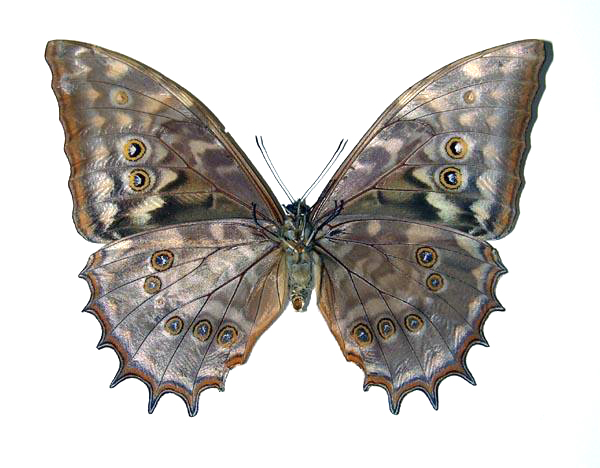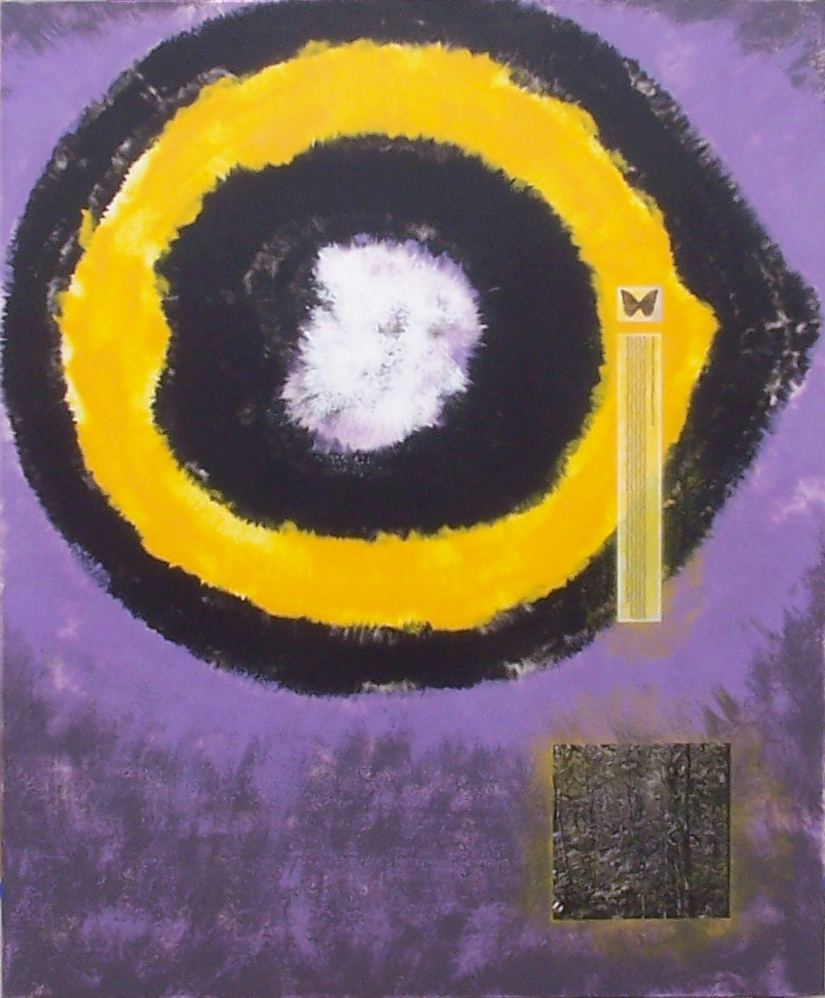Butterfly Mimicry
Morpho justitiae Butterfly
Costa Rica
From the researcher's perspective...
When you say “morpho”, everybody thinks “big blue thing flopping along the roadside anywhere in ACG” (cloud forest, rain forest, dry forest—Morpho peleides; rain forest only—Morpho amathonte, Morpho granadensis). But there are others. The flying sheets of white paper high in the cloud forest canopy in August—the one flight season for this univoltine species—is the white morpho that only the most fanatic butterfly watchers meet (Morpho polyphemus). And then there are the brown to beige/pearly ones – Morpho justitiae—whose underside we portray.
M. justitiae has an enigmatic adult, at least in ACG. While the white morpho can be found reliably on the tops of the volcanoes in August, and blue morphos are sort of everywhere all the time, the inventory met brown morphos first in 1991 when suddenly in March they were flying up and down all the trails on Volcan Cacao at 1000-1400 meters. And then they were not seen again for a decade. Then the inventory met them again, this time as caterpillars on what we now know is perhaps their sole ACG food plant, the large perennial vine Abuta panamensis (Menispermaceae) at intermediate elevation rain forest. Where were they in between, and where are they now when these food plants are largely or entirely free of their very distinctive caterpillars? Perhaps the population moves wildly from place to place, always dependent on this one food plant for caterpillar food. If this is the case, it is a quite different style from the blue morphos whose caterpillars feed on a variety of species of Fabaceae and even some other distant plant families. Now is the time for the new tiny transmitters to be glued to the back of a brown M. justitiae and followed for many kilometers to who knows where.
M. justitiae eggs are laid in 10–30-member batches and the early instars feed side-by-side on the large leaves of Abuta. When they reach the last instar, they are found solitarily scattered over the food plant, still ostentatious but showing no inclination to remain near their siblings. Not only does M. justitiae differ by being gregarious and very host-specific (the other morphos lay one egg at a time and have quite solitary caterpillars), but the caterpillars of M. justitiae—at least to date—are also only parasitized by a single undescribed species of Hyphantrophaga tachinid fly, one that attack only M. justitiae caterpillars. Where is this fly when the caterpillars are not present, or are we to hypothesis that it too moves long distances? And the caterpillars of the other four species of ACG morpho do not offer an answer—they are attacked by their own distinctive other undescribed species of Hyphantrophaga.
Dr. Daniel JanzenDNA Barcode of Morpho justitiae
Accessed from Barcode of Life Data Systems
MHMXN184-07 | 07-SRNP-21285 | Morpho justitiae | COI-5P
AACTTTATATTTTATTTTTGGAATTTGAGCAGGAATAATTGGTACTTCTCTTAGTCTTATTATTCGAACTGAATT AGGAAACCCAAGATTTCTCATTGGAGATGATCAAATTTATAATACTATTGTAACAGCACATGCTTTTATTATAAT TTTTTTTATAGTTATGCCAATTATAATTGGAGGATTTGGGAATTGACTTGTACCTTTAATACTTGGAGCCCCTGA TATAGCTTTCCCCCGAATAAATAATATAAGATTCTGATTACTTCCCCCTTCTTTAATACTCTTAATCTCAAGTAG TATTGTAGAAAATGGAGCTGGAACAGGATGAACTGTTTACCCCCCACTTTCATCTAATATTGCGCACAGAGGAAC TTCAGTAGATTTAGCTATTTTCTCATTACATTTAGCTGGAATTTCTTCTATTTTAGGAGCCATTAATTTTATTAC TACAATTATTAATATACGAATTAATAATATATCTTATGATCAAATACCTTTATTTGTTTGAGCTGTTGGAATTAC TGCTTTATTACTTTTATTATCTTTACCTGTTTTAGCAGGTGCTATTACTATACTTTTAACAGATCGAAATTTAAA TACTTCATTTTTTGACCCAGCTGGGGGAGGAGATCCAATTCTTTATCAACATTTATTT


